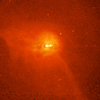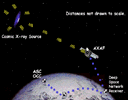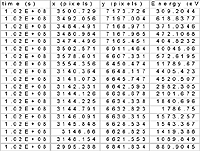Notes on Images & Processing
ACIS Readout streak |
| M87 |
For bright sources, images made with ACIS will contain linear streaks. These occur because for bright sources, photons will strike the detector while the CCD chip is being read out . These photons will be registered in the wrong postion, so for a bright source, a bright streak will appear all along the column (on both sides of the source, since some events are from the previous exposure).
Managing Chandra's Data Flow
 |
| Deep Space Network |
Chandra's images are fascinating, informative, and beautiful, but they arrive at the Chandra X-ray Center as a stream of 0's and 1's that only a computer jock could love. It takes at lot of technical know-how and TLC to convert them into something that a scientist can use, and normal people (not to imply that scientists aren't also normal people) can admire. This difficult job falls on the Data Systems group under the direction of Giuseppina (Pepi) Fabbiano, with major help from other groups, especially the Science Operations Team. More...
Processing Chandra Data Through CIAO |
| A sample portion of a Chandra dataset file. |
As previously explored by the Chandra Chronicles, getting the river of data from the Chandra Observatory to scientists is a complex process. But guiding and converting this data river of 1s and 0s is only the first step in the process of doing science with Chandra. What is the next step? The answer: The data torrent that flows from Chandra must be put through the mechanisms of a software waterworks. More...
OpenFITS - Create Images from Raw DataWith a basic understanding of astronomy data and image processing software, you can create your own astronomy images from FITS files. "FITS," which stands for Flexible Image Transport System, is a digital file format used mainly by astronomers. In this section you can download FITS files for some of our favorite Chandra images and learn how to compose your own versions of these high-energy atronomy images. More
Image Genetics: Astronomy Visualization Metadata (AVM)Chandra X-ray Observatory data is inherently digital. As such the Chandra group makes a concerted effort to encode all Chandra images with Astronomy Visualization Metadata, or AVM. Tagging astronomical images with AVM ensures that key information such as image description, object type, location, coordinates and more, stays linked to the image as it travels through the Internet. By keeping content embedded with the imagery, the outreach potential of each image released with metadata is increased dramatically. More


